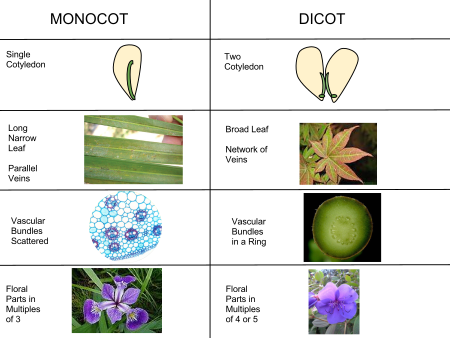Monocots and Dicots are two kinds of plants. Their difference is the number of cotyledons they have.
Cotyledon is a structure found in embryonic plants, that helps them survive the early stages of development. It provides nutrition for the newly germinated plants. It resembles a leaf in structure.
The distinction between monocots and dicots is used to categorize plants.
Index
Monocots and Dicots: Key Differences
The key differences between monocots and dicots are summarized below:

| Monocots | Dicots |
| They have one cotyledon. | They have two cotyledons. |
| They have a fibrous root system. | They have a tap root system. |
| The leaves are isobilateral. | The leaves are dorsiventral. |
| They have parallel venation. | They have reticulate venation. |
| The vascular bundles are scattered. | They have complex ring-like arrangement of vascular bundles. |
| Secondary growth is absent. | Secondary growth is present. |
| Cambium is absent. | Cambium is present. |
| Floral parts are multiples of 3. | Floral parts are in multiples of 4 or 5. |
Terminology Explained
Now, let’s look at some of the terminologies involved here.
Root Systems
It refers to how the roots are arranged.
Fibrous Root System
- The roots all start from a common point.
- They are all similar in size
- There is no one major root
- They do not penetrate deep into soil.
Tap Root System
- There is one major root, called the tap root, from which other smaller roots develop from.
- They penetrate deeper into the soil.
Leaf Structure
Isobilateral
- The mesophyll is not differentiated.
- The internal structure looks the same from both sides.
- Stomata are equal on both sides of leaf.
Dorsiventral
- The mesophyll is differentiated.
- This means that there is a distinct difference in upper and lower sides of leaf.
- Stomata are more on lower side of leaf.
Venation
It refers to how veins are arranged in the leaf.
Parallel Venation
- All veins are similar in size and appearance.
- They run parallel to each other in the leaf.
Reticulate Venation
- There are thicker and thinner veins.
- The thicker veins branch out into thinner veins.
- It is hence also called net-like venation.
Arrangement of Vascular Bundles
- Vascular bundles are found in the stem and root.
- They carry materials throughout the plant.
- In monocots, they are all scattered in the stem and root.
- In dicots, they are placed in more complex ring-like structure.
Secondary Growth and Cambium
Secondary growth causes the thickening of stem and roots in plants. It happens only in dicots and very rarely in monocots.
Cambium is the tissue that leads to secondary growth in dicots. Naturally, it is found in dicots.
Floral parts
- This refers to all parts of flowers like petals, sepals, etc.
- Monocot flowers tend to have parts in multiples of 3.
- Dicot flowers have parts in multiples of 4 or 5.
FAQs
Five features that are differences between monocots and dicots are:
1. Number of cotyledons in embryo
2. Root System
3. Venation of Leaf
4. Floral parts
5. Leaf structure
A dicot seed, such as groundnut, can be split into two symmetric halves while, a monocot seed, like rice, cannot be split into two even halves.
Monocot Plants: Rice, corn, grass, wheat.
Dicot Plants: Pea, groundnut, tomato, lentils.
Cotyledon provides nutrition for the embryo to germinate and develop into a sapling. It lets it survive till it can live on its own.
Similar Articles
